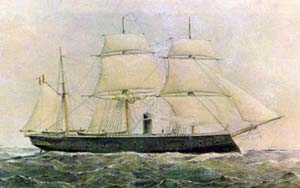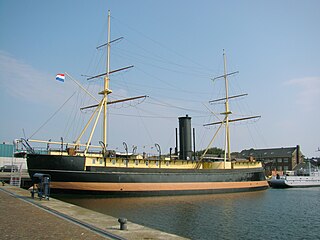
The Greek ironclad Vasilissa Olga was purchased from Chile for the Royal Hellenic Navy in 1868. She was converted into a training ship in 1897 and scrapped in 1925.

The French ironclad Normandie was the third and last of the three wooden-hulled Gloire-class ironclads built for the French Navy in 1858–62. The ships of the Gloire class were classified as armoured frigates because they only had a single gun deck and their traditional disposition of guns arrayed along the length of the hull also meant that they were broadside ironclads. Normandie was the first ironclad to cross the Atlantic in support of the French intervention in Mexico in 1862. Although the ship was active during the Franco-Prussian War of 1870–71, she saw no action. The unseasoned timber of her hull rotted quickly; she was condemned in 1871 and subsequently scrapped.

The Ruggiero di Lauria class was a class of ironclad battleships built for the Italian Regia Marina during the late 19th century. The three ships—Ruggiero di Lauria, Francesco Morosini, and Andrea Doria–were improved versions of the earlier Duilio-class ironclads. The primary improvements were new breech-loading guns, better armor protection, and more powerful machinery. The ships, designed by Giuseppe Micheli, marked a temporary diversion from the ideas of Benedetto Brin, who had designed the two preceding classes along with the following class.

HNoMS Mjølner was the fourth of five ships of the John Ericsson-class monitors built for the Royal Swedish Navy and the Royal Norwegian Navy in the mid-1860s. Impressed by the use of ironclads during the American Civil War, the design was based on that of USS Monitor. They were designed under the supervision of the Swedish-born inventor, John Ericsson—coincidentally, designer of Monitor—, and built in Sweden. Mjølner was delivered in 1868 and ran aground the following year, although she was not seriously damaged. The ship was reconstructed in 1897 and given modern breech-loading guns. Mjølner was sold for scrap in 1909.

The Brazilian monitor Bahia was originally ordered by Paraguay in 1864 with the name Minerva, but was sold to Brazil when Paraguay defaulted on the payments. She participated in the 1864–70 War of the Triple Alliance between Brazil, Argentina and Uruguay against Paraguay, and took part in the Passage of Humaitá.

The Danish ironclad Lindormen was a monitor built for the Royal Danish Navy in the 1860s. She was scrapped in 1907.

BAP Independencia was a broadside ironclad built in England for the Peruvian Navy during the mid-1860s. During the War of the Pacific of 1879–83, Independencia ran aground while pursuing the Chilean schooner Covadonga during the Battle of Punta Gruesa on 21 May 1879. The survivors were rescued by Huáscar and the wreck destroyed to prevent its capture.

The Russian ironclad Kniaz Pozharsky was an iron-hulled armored frigate built for the Imperial Russian Navy during the 1860s. She was the first Russian armored ship to leave European waters when she cruised the Pacific Ocean in 1873–75. The ship did not participate in the Russo-Turkish War of 1877–78, and remained in the Baltic Sea until 1879–80, when she made another cruise to the Pacific. Kniaz Pozharsky was assigned to the Baltic Fleet for the rest of her career. She mainly served as a training ship after her refit in 1885 until she was hulked in 1909 and probably scrapped in 1911.

ARA Almirante Brown was a central battery ironclad of the Argentine Navy built in the 1880s by Samuda Brothers in London. Almirante Brown displaced 4,200 long tons (4,300 t) and had a top speed of 14 knots. The ship was protected by a belt of nine-inch (230 mm) steel-faced armor and she carried a main battery of eight breech-loading guns. She was among the first major warships in the world to use steel armor, and remained the largest vessel in the Argentine fleet for over 15 years. Almirante Brown had a peaceful career in the fleet during the 1880s and 1890s. By the 1920s, she was reduced to a coastal defense ship, and remained in service until the early 1930s. She was stricken from the naval register in November 1932 and sold for scrapping.

Vasco da Gama was an ironclad of the Portuguese Navy built in the 1870s by the Thames Iron Works in London. Ordered to strengthen the defenses of the Portuguese capital of Lisbon, Vasco da Gama was launched in 1876 and completed in 1878. She served as the flagship of the Portuguese fleet for the majority of her long and peaceful career. She was rebuilt and heavily modernized between 1901 and 1903. Her crew was involved in revolts in 1913 and 1914; during the latter event, they bombarded Lisbon and killed around one hundred people. Long-since obsolete by the 1930s, Vasco da Gama was finally sold for scrapping in 1935.

The Duilio class was a pair of ironclad turret ships built for the Royal Italian Navy in the 1870s and 1880s. The two ships, Duilio and Enrico Dandolo, were fitted with the largest guns available, 450 mm (17.7 in) rifled muzzle-loading guns, and were the largest, fastest and most powerful ships of their day. To save weight on such large vessels, the ship's designer, Benedetto Brin adopted a radical solution for the time: he reserved armor only for the central portion of the ship where it protected the ships' engines and ammunition magazines, while the rest of the hull were extensively sub-divided with watertight compartments.

The Schorpioen-class monitors were a pair of ironclad monitors built abroad for the Royal Netherlands Navy in the 1860s. They had uneventful careers and were stricken from the Navy List in the first decade of the 20th century. Stier became a target ship and was sunk in 1925. Schorpioen was converted into an accommodation ship in 1909. She was captured by the Germans during World War 2, but survived the war. She remained in service until 1982 and then became a museum ship.

ARA Los Andes was one of two El Plata-class monitors built in Britain in the 1870s for the Argentine Navy.

The El Plata class consisted of a pair of monitors built in Britain in the 1870s for the Argentine Navy. They served as coastal defence ships.
The Greek ironclad Vasilefs Georgios was an armored corvette built in Great Britain for the Royal Hellenic Navy during the 1860s. She became a cadet training ship before she was stricken from the Navy List in 1912. The ship was scrapped in 1915.

The Costa Sur-class cargo ship is a class of three cargo ships designed and built in Argentina in 1975–1979 for servicing the Patagonic coast routes; capable of transporting bulk cargo, live cattle, and containers. The ships have been in service with the Argentine Navy since 1978. The class is named after the southern coastal area of Argentina which was designed to service.

NRP Douro was a Guadiana-class destroyer built for the Portuguese Navy in the 1910s.

NRP Guadiana was the lead ship of the Guadiana class of destroyers built for the Portuguese Navy in the 1910s.

















